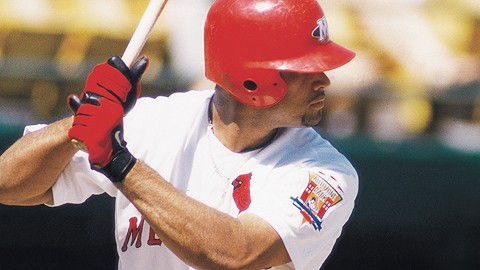As Major League Baseball opens the first made-for-TV season in the sport’s history, 30 clubs will be measured by four components: pitching, hitting, fielding, and what might best be described as bubble management. The defending-champion Washington Nationals return the best one-two pitching punch in the game: Max Scherzer and Stephen Strasburg. They have one of the most exciting young sluggers in the game in Juan Soto. They lost a slick-fielding third baseman when Anthony Rendon departed for the Los Angeles Angels. But here’s the question that may decide the champs’ 2020 fate: How antisocial are the Nats?
 Taka Yanagimoto / St. Louis Cardinals
Taka Yanagimoto / St. Louis Cardinals
Mike Shildt
This is where we are in the age of coronavirus. A baseball team’s starting rotation will only be as strong as the five men in that group are at self-isolation. An urge to stray outside a team’s “bubble” — whether at home or on the road — could prove catastrophic when “quarantine” and “contact-tracing” become part of the box scores we check in the morning. There’s never been required teamwork quite like this. How smoothly your favorite team’s shortstop and second baseman turn the pivot may be less important than how quickly your outfielders don their masks upon leaving the ballpark.
AutoZone Park will remain dormant, as the St. Louis Cardinals’ minor-league training camp will be housed in Springfield, Missouri (home of the franchise’s Double-A club). But several former Memphis Redbirds — including skipper Mike Shildt, the 2019 National League Manager of the Year — will help determine if the upcoming 60-game season will be memorable for reasons beyond its brevity. Here are seven to watch.
Yadier Molina — The 38-year-old catcher’s remarkable streak of 15 consecutive seasons with more than 100 games behind the plate will come to an end, but Molina has a pair of significant milestones within reach. He needs 37 hits to reach 2,000 for his career, a number that should all but punch a Hall of Fame ticket for the nine-time Gold Glove winner. And when he plays his 17th game this season, he’ll become only the third man — after Stan Musial and Lou Brock — to play 2,000 games for the Cardinals.
Adam Wainwright — Like Molina, Wainwright — who turns 39 in August — is climbing some significant charts in the record book. With two wins, Wainwright would move past Bob Forsch (163) for third place on the Cardinals’ career chart. Should he start six games with Molina behind the plate, the two will climb into sixth all-time for games played as battery mates. (Six more would give them 271, the most in a half-century.)
Jack Flaherty — In a regular season squeezed down to two months, pitching will be more of a premium than ever, and Flaherty enters the season as the Cardinals’ unquestioned ace. Still only 24 years old, Flaherty is coming off a season in which he struck out 231 hitters, the most by a Cardinal since Hall of Famer Bob Gibson in 1970. A team simply cannot endure a losing streak in the abbreviated campaign, and Flaherty would appear to be the antidote for such.
Tommy Edman — The 25-year-old Edman can be classified as a throwback player, a utility man — remember that tag? — who can play six positions, bat at the top or bottom of the batting order, and bring speed to both the base paths and the field. Look for Edman to play every day, but check the lineup for exactly where.
Paul DeJong — If you asked me to identify a player most likely to be a Cardinal in the year 2030, I’d go with DeJong (who turns 27 next month). After less than two months in Memphis, DeJong took over at shortstop for the Cardinals in 2017 and has slugged 74 home runs in the three seasons since (30 last year). He’s emerged as a strong fielder and was the Cardinals’ lone representative in the 2019 All-Star Game. If he can cut down on the strikeouts (149 last season), DeJong has several more All-Star trips in his future.
Matt Carpenter — The designated hitter has arrived in the National League, and Carpenter could be the man to make it a position of impact for St. Louis. Having bounced from second base to third and over to first since 2012, Carpenter has been a hitter without a position to call his own. Having lost 89 RBIs when Marcell Ozuna departed for Atlanta, the Cardinals desperately need the 34-year-old Carpenter to find his All-Star form at the plate. After drilling 36 homers and finishing ninth in MVP voting after the 2018 season, Carpenter slumped to a slash line of .226/.334/.392 (with 15 homers) in 2019.
Carlos Martinez — The team’s ace as a starter merely three years ago, Martinez took over closer duty last season when Jordan Hicks went down for Tommy John surgery. While he’d like to start again, Martinez would bring a degree of ninth-inning certainty to a team that will, presumably, play a lot of low-scoring games.

